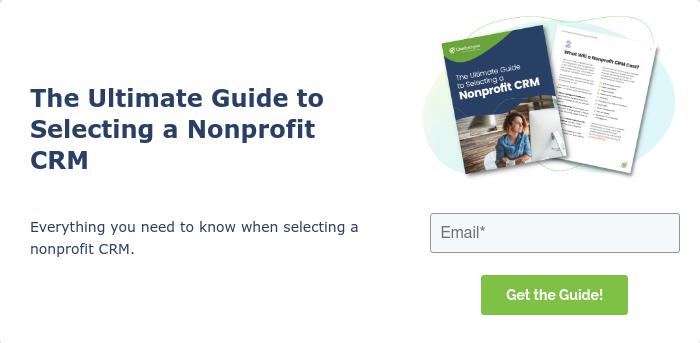-2.png)
In my decades-long nonprofit career, I’ve written more RFPs than I care to count. And then I’ve been overwhelmed by the dozens of proposals that flooded my inbox! Over the years, I’ve learned that writing the most perfect RFP for your nonprofit is the best way to get fewer irrelevant proposals and more high-quality proposals customized for your needs.
As the Vice President of Sales for CharityEngine, I’m now on the other side. I see nonprofit RFPs come across my desk and I consider whether or not our fundraising platform would be a good fit. And I’ve quickly learned how to spot helpful, thoughtful RFPs. In this article, I’ll give you ten steps to writing an RFP to get you the exact responses you hope to see.
Why Write a Nonprofit RFP?
This is a good question. Can’t you just talk to fellow nonprofit executives, see which technology they’re using, and then call that company?
You can, but even if you’re not publishing your RFP or sending it to vendors, it’s an excellent exercise whenever you need a new nonprofit CRM. Starting with goals and working your way back to technology requirements allows you to consider carefully and even map out overarching plans for your nonprofit.
Here are some ways the process of writing an RFP can benefit your nonprofit:
- Thinking through your technology needs can help you create a fundraising blueprint for your nonprofit. If, for example, events will be the primary source of fundraising, you will know to include event-specific functionality in your RFP.
- Once you have created an RFP, you’ll have standardized your expectations. Therefore, regardless of how you communicate your need for new technology, each vendor can be evaluated against the same standards. Rather than going by your gut, you’ll have the data to see which vendor’s technology is the best match.
- Switching CRMs is a big project. In writing an RFP, your nonprofit will have a clearly defined scope of work for the technology change. You will cement deliverables, milestones, and other standards by which you’ll understand the progress and success of the project.
Writing an RFP greatly increases your chances of finding the right partner. It pulls together input from your team and helps you consider future fundraising plans. Starting with a well-thought-out RFP will help you find the technology that will most heavily increase your impact.
10 Steps for Nonprofit RFPs
You’ve decided to write the RFP, so now what? Based on my experience, following these steps will be key to producing the best RFP.
1. Understand your objectives.
Before you even think of new technology, take a good look at your current tech stack. What works? What doesn’t? What would work if it was tweaked a little? This will help you define the functionality you’re looking for and ensure you’re not going to have the same issues with a new CRM.
2. Define your needs.
What are your technology goals? Do you want dashboards to consolidate data and display what you need? Do you need one platform with native tools, one with robust APIs for integration, or one that offers both? How important is onboarding support or always-on customer service?
3. List your must-have features.
Of course, you want donor management, but do you need email? If you have email, do you want it in your CRM, or are you okay with logging into a third party? How about peer-to-peer, advocacy, or volunteer management? This list of essential nonprofit CRM features might be a helpful checklist as you consider this step.
4. Consider customization.
You’re buying the engine to run your donor management and fundraising, and there’s no other nonprofit like you. Think about what specific customization you might need. Does your nonprofit have to integrate with a Learning Management System or a platform specific to your industry?
5. Choose RFP recipients wisely.
If there’s a technology widely used (and loved) by nonprofits with similar missions, that’s a vendor to include. You can always look at online reviews. When searching for new technology at Help Heal Veterans, I looked at the undisputed leader in veteran-service nonprofits: Wounded Warrior Project. I wanted whatever tech they were using. (It was CharityEngine!) Ask around, check references, and evaluate potential vendors as long-term partners. Anyone who wants a quick transaction should be off the list.
6. Don’t forget compliance and security.
Give yourself a quick lesson on the terms, especially for payment processing. Understand the difference between PCI compliance and PCI certification. Ask about data security protocols, like SOC 2 certification, and encryption. A good CRM vendor can walk you through compliance and anti-fraud measures without hesitation, so include your requirements in your RFP.
7. Let’s talk onboarding and implementation.
One of the scariest parts of new technology is knowing that the friendly sales team will hand you off to a harried onboarding team. Put parameters around what you think implementation should look like! If you don’t have confidence the team will hold your hand and make sure you’re comfortable before setting you free, it’s a red flag.
8. Cost is critical…
It’s not just the cost of the technology. How much is onboarding? Do you pay for system updates? Are there tiers of support you’ll want to investigate? From initial setup to ongoing maintenance, know the total cost of your contract. If you want to include budget information in your RFP, you can do so. Just be sure you consider all aspects.
9. …But ROI is as important as cost.
Not to throw a wrench in the conversation, but it’s also important to look beyond the dollars and cents and consider the ROI of a system. The idea behind the ROI is that you want to use the fundraising software that will bring in the most fundraising dollars if that’s your goal. Or influence most policies if advocacy is your goal. Think about how you could increase the ROI of a system and add that to your RFP or your evaluation.
10. Plan deployment and rollout.
Finally, detail your expectations around the launch. Include as much as you want in the RFP, but ensure you have an internal plan and expectations so you can plan accordingly. When including your training requirements, think about your staff. Does your board need training? Specify your requirements in your RFP, so all parties know what to expect.
Nonprofit RFPs: The First Step to New Tech
Once you’ve gone through these steps, you will have considered everything from features and functionality to cost and training (and everything in between). Crafting an RFP is an excellent exercise as it forces you to carefully examine your technology, donor management, and fundraising needs. It’s a smart way to start.
As I mentioned, I’m a nonprofit veteran (and literally a veteran—Navy!) and now I work on the nonprofit CRM side. I’m always happy to chat with nonprofits about how you can be a smarter fundraiser! If you’d like to talk or learn more about CharityEngine, book a demo with us and let us show you how CharityEngine can revolutionize your fundraising.





-1.png)